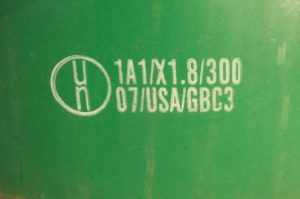Question:
Subject: Container head space for UN rated drums containing liquids
Message Body:
Are there any regulations in reference to how much liquid can be added to a drum? e.g. 1A1 – 55 gal drum. When dealing with drums containing flammable liquids during summer months to ensure adequate container head space for vapor expansion. Most in the industry have a “rule of thumb”…
Answer:
Thank you for contacting me. There are several regulatory requirements applicable to the filling of packagings with a hazardous material (HazMat) prior to offering it for transportation. Please see below for some initial clarification:
- My answers are derived from the Hazardous Materials Regulations (HMR) of the Pipeline and Hazardous Materials Safety Administration within the U.S. Department of Transportation (USDOT/PHMSA).
- The HMR applies to the preparation for and transportation in commerce of HazMat to, from, or anywhere through the U.S.
- Other agencies – domestic and international – may have regulations applicable to this situation; they won’t be considered here.
- The packaging you describe: “1A1 – 55 gal drum” is a non-bulk packaging.
- More specifically, a 1A1 is a steel drum with a non-removable head made to the non-bulk performance oriented standard (aka: UN Standard) at 49 CFR 178, subpart L.
Please see below for the relevant regulations of the HMR and a summary of their requirements:
- Note: all of the below regulations are found within §173, Subpart B. These are the shipper’s responsibilities for the preparation of HazMat for transportation.
- §173.24(b) – each HazMat package must be filled, its contents so limited, and closed…so that under normal transportation conditions there will be no identifiable (without the use of instruments) release of HazMat. Also, there may be no HazMat residue on the outside of the package.
- Note: the above regulation does not define what is meant by “its contents so limited”. The person filling the packaging must determine how to limit the contents in order to prevent an identifiable release.
- §173.24(h) – when filling packages with a liquid HazMat, sufficient ullage (aka: headspace or outage) must be left to ensure no leakage or distortion of the package will occur due to expansion of liquid caused by temperatures likely to be encountered during transportation.
- Note: the above regulation does not specify a limit not to exceed when filling a packaging with a liquid HazMat. Rather, the shipper must determine what is “sufficient ullage”. Also, “sufficient ullage” will vary based on the temperature likely to be encountered during transportation, i.e., summer v. winter and low v. high elevation.
- §173.24a(b) – This paragraph describes non-bulk packaging filling limits. However, it is not applicable to your question for the following reasons:
- For packagings designed for HazMat liquids, it doesn’t specify a volume limit but instead indicates a maximum relative density for the HazMat liquid that is marked on the packaging.
- Packagings designed for solid HazMat have a maximum gross mass that must be marked on the package. However, this is not applicable to a liquid HazMat.
- §173.24a(d) – specific to a non-bulk packaging: “Liquids must not completely fill a receptacle at a temperature of 55 °C (131 °F) or less.”
- §173.24b(a) – this specifies outage and filling limits for a bulk packaging. It is not applicable to this non-bulk packaging.
|
Daniels Training Services, Inc. 815.821.1550 |
Is that it?
No.
Pursuant to §178.2(c), the manufacturer of a packaging and any subsequent distributor must provide the shipper with all the information necessary to ensure the packaging is filled, closed, and prepared for transportation in a form able to pass the packaging’s performance tests at §178, Subpart M. These are usually referred to as the packaging’s closure instructions.
The closure instructions may specify a maximum fill volume for the packaging that is less than its rated capacity and less than the values determined through use of the above described regulations in the HMR. The shipper must obtain the “closure instructions”, follow them to the letter, and maintain a copy of them for at least 90 days after the packaging is offered for off-site transportation.
|
Contact me the next time your USDOT, training is due to expire. |
In conclusion: yes. There are regulations in the HMR affecting the liquid filling of HazMat packagings. Unfortunately, the regulations place the responsibility on the shipper to determine what those limits are. And, no. A “rule of thumb” won’t suffice.
I hope this helps. Please contact me with any other questions.
